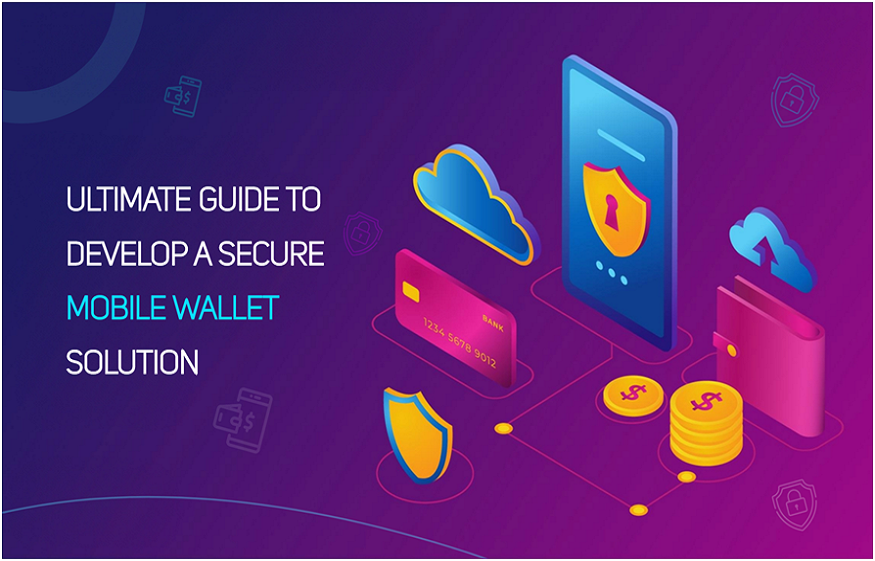Ultimate Guide to Develop a Secure Mobile Wallet Solution

Mobile wallet apps has grown in popularity in recent years and for good reason. They offer a simple and secure way for making digital payments with your mobile device, eliminating the requirement for cash or credit cards.
Businesses could benefit from developing a secure mobile wallet app. However, creating a secure mobile wallet solution is somewhat more difficult. So, in this blog, we’ll talk about how to develop a secure mobile wallet solution.
How does Secure Mobile Wallet work?
Mobile wallet apps securely keep a user’s payment data, like credit card or bank account information, in their databases.
When a user desires to initiate a payment, they can open the app and choose the appropriate payment option. The payment information is subsequently securely sent to the merchant’s payment gateway, which conducts the payment process.
For enabling transactions, mobile wallet applications employ a variety of technologies. Let’s have a look at them.
- Quick Response (QR) codes – Users can make purchases through the use of their smartphone camera to scan a code shown on the merchant’s payment terminal.
- UPI (Unified Payment Interface) – Through an automated two-factor authentication process, the real-time payment system supports peer-to-peer interbank transactions, offering users a safe and effective transaction experience. This technology reduces the requirement for users to repeatedly enter confidential data such as CVV codes and PINs, leading to a simple and quick transaction procedure.
- Near Field Communication (NFC) – This technology enables the exchange of payment information between the two nearest NFC-enabled devices. Particularly, shops must have the necessary technology in order to accept NFC mobile payments. Yet, most modern payment terminals are equipped with NFC technology and chip readers, removing the need for equipment.
- MST (Magnetic Secure Transmission) – By swiping, this technology generates a magnetic signal that resembles a traditional payment card, allowing users to make payments quickly and easily without having to manually retrieve their wallet.
Steps to Develop a Secure Mobile Wallet Solution
Here are the different steps to develop a secure mobile wallet solution
1. Product Ideation
The first step for developing a mobile wallet app is determining or discovering the project scope.
With the assistance of the best mobile app development company, you can verify the business idea of establishing a mobile wallet app, evaluate the idea with potential customers, and determine the technical specifications needed for developing a successful mobile application.
This phase helps you grasp the difficulties that frequently arise in digital wallet system design and solution development. At this level, each team member interacts successfully with the necessary technology stacks to evaluate the product idea’s technical as well as business potential.
2. Designing
In this step, your partnered company assists you in giving your mobile wallet an appearance and feel by creating a user interface and user experience. It will provide a user-friendly and visually beautiful app for the user to utilize and review.
You can choose and create a brand logo, application icon, button, and other digital wallet elements to set your product apart from the competition.
It will act as an architectural blueprint for developers to use in coding the application modules and establishing features amongst them to create the end product.
3. Development and Testing
The most technical component of the process is mobile app development and testing. The team of developers deploys technology stacks, configures CI/CD, and tests and validates if the product works as expected based on the standards of the UI/UX.
4. App Launch
In this step, your mobile wallet must be hosted on popular app stores like Google Play and Apple Store. With this approach, you make your application downloadable for the intended audience according to the operating system they use.
5. Maintenance and Support
The development of a secure mobile wallet is a one-time task, but maintaining it up to date with market demands falls under support and maintenance, which is a continuous endeavor.
Therefore, you can hire Indian app developers who assist with application support and maintenance in order to keep the app up-to-date, functioning, and efficient while correcting issues or bugs that may have happened after launch.
Types of Mobile Wallet Solutions
The following are the types of mobile wallet solutions:
1. Closed Wallet
These apps are intended to be used to make payments for a certain store, app, or website. Businesses use these wallets to market items or services to their target clientele.
In addition, a user can only utilize a closed wallet to make payments to the wallet’s issuer. It only serves a small number of people, and refunds are saved in the wallet.
Walmart Pay, Amazon Pay, and other similar services are examples of Closed Wallets.
2. Semi-Closed Wallet
The development of semi-closed digital wallet technology allows you to act as a unified payment system among merchants and customers.
Customers must supply personal information such as their bank or debit card number, location, and other identity verification such as creating pins to ensure safe payment processes, whereas businesses commit to an agreement or contract with you in order to use the system.
Google Pay and Apple Pay are examples of Semi-Closed Wallets.
3. Open Wallet
These are the most widely used mobile wallets, allowing transactions to another mobile wallet to be made utilizing a single platform. However, both the sender and the receiver must have user accounts on the same app.
Paypal and American Express are examples of Open Wallets.
4. Cryptocurrency Wallets
These wallets enable the storage and transfer of cryptocurrency. Users’ public and private keys are saved in crypto wallets as cryptocurrency ownership certificates.
Binance and Coinbase are examples of Cryptocurrency Wallets.
5. IoT Wallets
The Internet of Things (IoT) enables eWallets on wearable devices such as smartwatches, wristbands, and so on, as well as smart electronic equipment such as smart refrigerators. E-money or virtual currencies are used in IoT wallets.
Fitbit Pay is an example of an IoT Wallet.
Factors to Consider when Developing a Secure Mobile Wallet Solution
Here are some factors that you need to consider while developing a secure mobile wallet solution:
1. Function Prioritizing
A mobile wallet application consists of various functions and features. Thus, integrating basic features is crucial for success.
A well-known Android app development services provider suggested that you must conduct thorough market research to understand customer expectations, demands, and market trends before building a mobile wallet app.
2. Security
Your mobile app will be profitable only if users can trust its security structure.
Customers must store their credit card details or input their passwords when using mobile wallets. It is your major responsibility to protect their data utilizing innovative technological methods.
You must incorporate technologies that are difficult to decrypt in addition to normal safety and security features.
3. Include Digital Receipt
Users must receive confirmation of transaction success or failure after each transaction. This is when a digital receipt comes in handy.
It is critical that they obtain a digital receipt of their payment transaction, regardless of how much they transacted. These electronic receipts can be delivered via email to the customer’s specified email address.
4. Reward Points
There’s no chance your users would depart your app in the next few days if you give them different incentives.
However, keep in mind that customers can check their reward points anytime they want and redeem them in more creative ways. At this step, you must grasp your target audience’s preferences and dislikes.
5. Keep your User Engaged
Send timely notifications to your customers about fresh deals. Share personalized coupons and deals with them to keep them interested in your app.
Users frequently abandon an app after the first use. Keeping customers updated on new offers and discounts will help you keep them interested in your digital payment app.
Conclusion
Developing a digital wallet might seem to be an intimidating endeavor. Security difficulties, domain intricacies, and technical issues all necessitate experience and a team of professionals.
So, don’t be hesitant to seek guidance and assistance when necessary. Contact a top fintech app development company to get your mobile wallet professionally designed.





